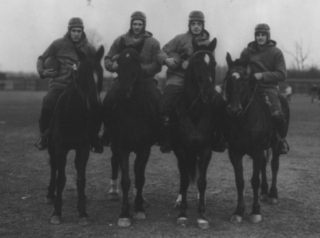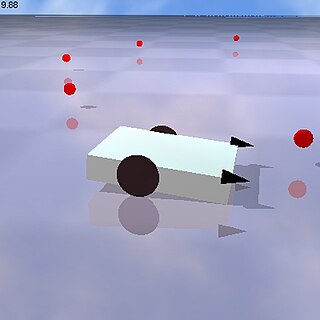Related Research Articles

Stigmergy is a mechanism of indirect coordination, through the environment, between agents or actions. The principle is that the trace left in the environment by an individual action stimulates the performance of a succeeding action by the same or different agent. Agents that respond to traces in the environment receive positive fitness benefits, reinforcing the likelihood of these behaviors becoming fixed within a population over time.


The Santa Fe Institute (SFI) is an independent, nonprofit theoretical research institute located in Santa Fe, New Mexico, United States and dedicated to the multidisciplinary study of the fundamental principles of complex adaptive systems, including physical, computational, biological, and social systems. The institute is ranked 24th among the world's "Top Science and Technology Think Tanks" and 24th among the world's "Best Transdisciplinary Research Think Tanks" according to the 2020 edition of the Global Go To Think Tank Index Reports, published annually by the University of Pennsylvania.

NetLogo is a programming language and integrated development environment (IDE) for agent-based modeling.

A multi-agent system is a computerized system composed of multiple interacting intelligent agents. Multi-agent systems can solve problems that are difficult or impossible for an individual agent or a monolithic system to solve. Intelligence may include methodic, functional, procedural approaches, algorithmic search or reinforcement learning.
An agent-based model (ABM) is a computational model for simulating the actions and interactions of autonomous agents in order to understand the behavior of a system and what governs its outcomes. It combines elements of game theory, complex systems, emergence, computational sociology, multi-agent systems, and evolutionary programming. Monte Carlo methods are used to understand the stochasticity of these models. Particularly within ecology, ABMs are also called individual-based models (IBMs). A review of recent literature on individual-based models, agent-based models, and multiagent systems shows that ABMs are used in many scientific domains including biology, ecology and social science. Agent-based modeling is related to, but distinct from, the concept of multi-agent systems or multi-agent simulation in that the goal of ABM is to search for explanatory insight into the collective behavior of agents obeying simple rules, typically in natural systems, rather than in designing agents or solving specific practical or engineering problems.
Swarm is the name of an open-source agent-based modeling simulation package, useful for simulating the interaction of agents and their emergent collective behaviour. Swarm was initially developed at the Santa Fe Institute in the mid-1990s, and since 1999 has been maintained by the non-profit Swarm Development Group. Also known as the Swarm Simulation System, it is available for free and use, covered by the GNU General Public License.

Christopher Gale Langton is an American computer scientist and one of the founders of the field of artificial life. He coined the term in the late 1980s when he organized the first "Workshop on the Synthesis and Simulation of Living Systems" at the Los Alamos National Laboratory in 1987. Following his time at Los Alamos, Langton joined the Santa Fe Institute (SFI), to continue his research on artificial life. He left SFI in the late 1990s, and abandoned his work on artificial life, publishing no research since that time.

Santa Fe Indian School (SFIS) is a tribal boarding secondary school in Santa Fe, New Mexico. It is affiliated with the Bureau of Indian Education (BIE).

A decentralised system in systems theory is a system in which lower level components operate on local information to accomplish global goals. The global pattern of behaviour is an emergent property of dynamical mechanisms that act upon local components, such as indirect communication, rather than the result of a central ordering influence of a centralised system.
The Krasnow Institute for Advanced Study brings together researchers from many disciplines to study the phenomenon known as the mind. A unit of George Mason University, the Krasnow Institute also serves as a center for doctoral education in neuroscience. Research at the institute is funded by agencies such as the National Institutes of Health, the National Science Foundation and the Department of Defense.
SFI may refer to:
David Liddle is co-founder of Interval Research Corporation, consulting professor of computer science at Stanford University. While at Xerox PARC he was credited with heading development of the Xerox Star computer system. In 1982 he co-founded Metaphor Computer Systems. He has served on the board of many corporations. He was chair of the board of trustees of the Santa Fe Institute from 1994 to 1999. Liddle holds a B.S. in computer science from the University of Michigan, and a Ph.D. in EECS from the University of Toledo, in Ohio.

The Railway Exchange Building, also known as Santa Fe Building, is a 17-story office building in the Historic Michigan Boulevard District of the Loop community area of Chicago in Cook County, Illinois, United States. It was designed by Frederick P. Dinkelberg of D. H. Burnham & Company in the Chicago style. Dinkelberg was also the associate designer to Daniel Burnham for the Flatiron Building in New York City.
The 2007 NCAA Division I men's soccer tournament was a tournament of 48 teams from NCAA Division I who played for the NCAA Championship in soccer. The College Cup for the final four teams was held at SAS Soccer Park in Cary, North Carolina. All other games were played at the home field of the higher-seeded team. The final was held on December 16, 2007.
The Center for Research Libraries is a consortium of North American universities, colleges, and independent research libraries, based on a buy-in concept for membership of the consortia. The consortium acquires and preserves traditional and digital resources for research and teaching and makes them available to member institutions through interlibrary loan and electronic delivery. It also gathers and analyzes data pertaining to the preservation of physical and digital resources, and fosters the sharing of expertise, in order to assist member libraries in maintaining their collections.

The 1924 college football season was the year of the Four Horsemen as the Notre Dame team, coached by Knute Rockne, won all of its games, including the Rose Bowl, to be acclaimed as the best team in the nation. Notre Dame and Stanford were both unbeaten at season's end, with the Fighting Irish winning the Rose Bowl contest 27–10. The Penn Quakers were retroactively awarded a national championship by Parke H. Davis.

AppScale is a software company offering cloud infrastructure software and services to enterprises, government agencies, contractors, and third-party service providers. The company commercially supports one software product, AppScale ATS, a managed hybrid cloud infrastructure software platform that emulates the core AWS APIs. In 2019, the company ended commercial support for its open-source serverless computing platform AppScale GTS, however, its source code remains freely available to the open-source community.

Artificial life is a field of study wherein researchers examine systems related to natural life, its processes, and its evolution, through the use of simulations with computer models, robotics, and biochemistry. The discipline was named by Christopher Langton, an American theoretical biologist, in 1986. In 1987 Langton organized the first conference on the field, in Los Alamos, New Mexico. There are three main kinds of alife, named for their approaches: soft, from software; hard, from hardware; and wet, from biochemistry. Artificial life researchers study traditional biology by trying to recreate aspects of biological phenomena.
Stephanie Forrest is an American computer scientist and director of the Biodesign Center for Biocomputing, Security and Society at the Biodesign Institute at Arizona State University. She was previously Distinguished Professor of Computer Science at the University of New Mexico in Albuquerque. She is best known for her work in adaptive systems, including genetic algorithms, computational immunology, biological modeling, automated software repair, and computer security.
References
- ↑ SwarmFest
- ↑ Ascape
- ↑ School of Computer Science, Telecommunications, and Information Systems
- ↑ SwarmFest2013
- ↑ "SwarmFest2014". Archived from the original on May 9, 2014. Retrieved May 8, 2014.
- ↑ "SwarmFest2015". Archived from the original on January 17, 2016. Retrieved February 14, 2018.
- ↑ SwarmFest2016
- ↑ SwarmFest2017